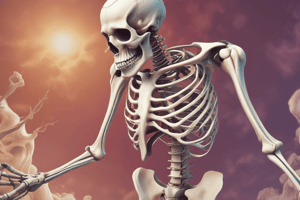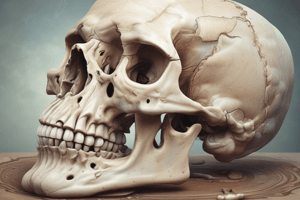Podcast
Questions and Answers
What is the most common cause of osteomyelitis?
What is the most common cause of osteomyelitis?
- Facial trauma
- Radiotherapy
- Odontogenic infections (correct)
- Malnutrition
What is MRONJ?
What is MRONJ?
- A condition associated with certain medications (correct)
- A type of cancer
- A rare genetic disorder
- A fungal infection
What is the most common cause of osteomyelitis?
What is the most common cause of osteomyelitis?
- Facial trauma
- Radiotherapy
- Odontogenic infections (correct)
- Diabetes
Which bone is more susceptible to osteomyelitis due to poor blood supply and dense cortical bone?
Which bone is more susceptible to osteomyelitis due to poor blood supply and dense cortical bone?
Which bone disease can increase susceptibility to osteomyelitis?
Which bone disease can increase susceptibility to osteomyelitis?
What are the characteristics of MRONJ?
What are the characteristics of MRONJ?
Which of the following diseases can increase susceptibility to osteomyelitis?
Which of the following diseases can increase susceptibility to osteomyelitis?
Which nerve can experience paresthesia in acute forms of osteomyelitis?
Which nerve can experience paresthesia in acute forms of osteomyelitis?
When was MRONJ updated in the AAOMS guidelines?
When was MRONJ updated in the AAOMS guidelines?
What is the etiology of osteomyelitis?
What is the etiology of osteomyelitis?
Which medications are associated with MRONJ?
Which medications are associated with MRONJ?
What is the most common location for osteomyelitis?
What is the most common location for osteomyelitis?
What is the duration of medication use's role in MRONJ?
What is the duration of medication use's role in MRONJ?
What can cause medication-related osteonecrosis of the jaws (MROJ)?
What can cause medication-related osteonecrosis of the jaws (MROJ)?
What are the symptoms of acute osteomyelitis?
What are the symptoms of acute osteomyelitis?
How can chronic osteomyelitis appear?
How can chronic osteomyelitis appear?
When is MRONJ diagnosed?
When is MRONJ diagnosed?
Which of the following is not a management option for osteomyelitis?
Which of the following is not a management option for osteomyelitis?
What is the etiology of osteomyelitis?
What is the etiology of osteomyelitis?
What are the consequences of MRONJ?
What are the consequences of MRONJ?
What is the treatment for osteomyelitis?
What is the treatment for osteomyelitis?
What is the difference between acute and chronic forms of osteomyelitis?
What is the difference between acute and chronic forms of osteomyelitis?
Which of the following can lead to osteomyelitis?
Which of the following can lead to osteomyelitis?
What is the treatment for MRONJ?
What is the treatment for MRONJ?
Which of the following is not a risk factor for osteomyelitis?
Which of the following is not a risk factor for osteomyelitis?
What are the prevention measures for MRONJ?
What are the prevention measures for MRONJ?
What must be improved for good healing of osteomyelitis?
What must be improved for good healing of osteomyelitis?
What is Medication-related osteonecrosis of the jaws (MROJ)?
What is Medication-related osteonecrosis of the jaws (MROJ)?
What is the risk associated with dentoalveolar surgery?
What is the risk associated with dentoalveolar surgery?
What must be improved for good healing of osteomyelitis?
What must be improved for good healing of osteomyelitis?
Which population is more likely to develop MRONJ?
Which population is more likely to develop MRONJ?
Which of the following is not a cause of osteomyelitis?
Which of the following is not a cause of osteomyelitis?
What is the primary symptom of chronic forms of osteomyelitis?
What is the primary symptom of chronic forms of osteomyelitis?
What is the most common symptom of chronic osteomyelitis?
What is the most common symptom of chronic osteomyelitis?
What is the recommended action before starting IV BP treatment?
What is the recommended action before starting IV BP treatment?
Which of the following is not an etiology of osteomyelitis?
Which of the following is not an etiology of osteomyelitis?
Flashcards are hidden until you start studying
Study Notes
- MRONJ is a condition associated with certain medications.
- Characteristics include exposure of bone and no history of radiation therapy or metastatic disease.
- The condition is updated in the AAOMS 2014 guidelines.
- Medications associated with MRONJ include those used for osteopenia/osteoporosis and malignancy.
- The duration of medication use is also a factor.
- MRONJ is diagnosed when exposed bone persists for more than 8 weeks.
- MRONJ is a serious condition that can cause pain and infection.
- Treatment may involve antibiotics, surgery, and discontinuation of the medication.
- Prevention measures include good oral hygiene and regular dental check-ups.
- Patients should discuss the risks and benefits of medication with their healthcare provider.
- Dentoalveolar surgery increases the risk of developing MRONJ.
- MRONJ is more likely to appear in the mandible than the maxilla.
- Pre-existing dental disease increases the risk of MRONJ.
- MRONJ is more prevalent in the female population.
- Dental examinations are recommended before starting IV BP treatment.
- The 2nd molar roots are closest to the maxillary sinus floor.
- Dental issues can cause maxillary sinusitis.
- Acute maxillary sinusitis can cause pain and facial fullness.
- Chronic maxillary sinusitis can be of dental origin and cause unilateral purulent secretion.
- Treatment for maxillary sinusitis includes antibiotics and removal of etiological factors.
Studying That Suits You
Use AI to generate personalized quizzes and flashcards to suit your learning preferences.




